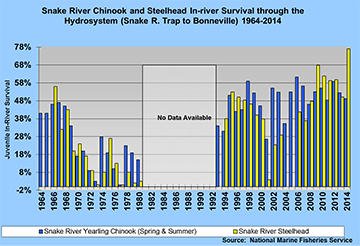March 15, 2015:Survival through the eight federal dams and reservoirs on the lower Snake and Columbia rivers was about average for juvenile chinook and the highest ever for juvenile steelhead and sockeye in 2014, the Northwest Fisheries Science Center reported.Snake River steelhead survival was estimated at 77.1 percent, sockeye at 71.3 percent, and Chinook at 49.7 percent. See the report here.
In a year where flow, spill and water temperature were all within average ranges, juvenile fish travel times through the hydrosystem continued to be shorter than before all eight dams had surface passage routes installed. NOAA scientists say that surface passage and spill have improved travel times. The surface flow is attractive and the fish spend less time in the forebay searching for the best route to pass. In the reservoirs, higher flows translate into faster water velocities.
Increased spill and use of surface passage may be helping the fish get past more quickly and safely, but the scientists cautioned that it is also making survival estimates more uncertain. Fish are tagged with devices that can only be detected if the fish go through the bypass system at the dams. Fewer and fewer fish are using these routes, in favor of spill and surface passage.

Improved fish passage installed at all lower Snake and Columbia federal dams